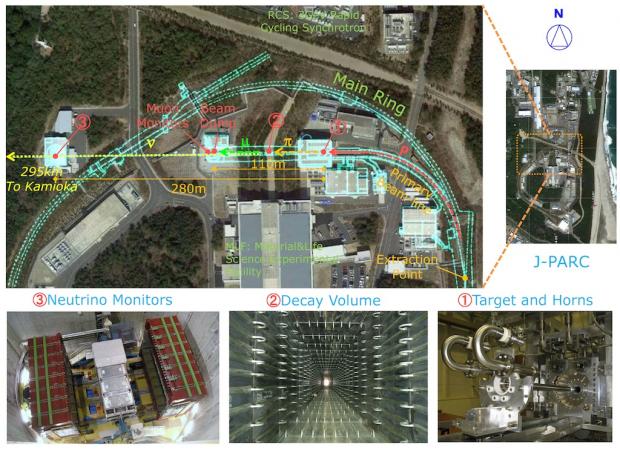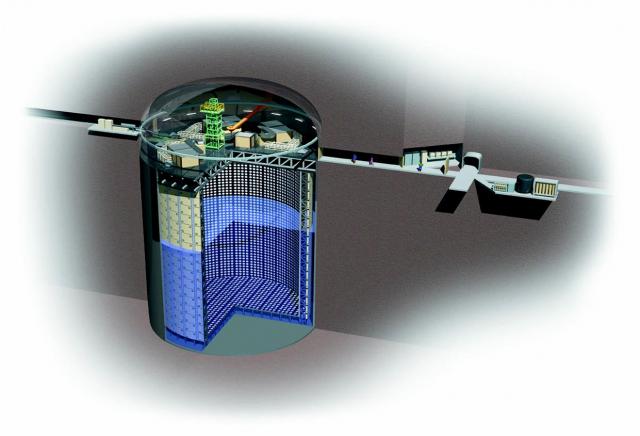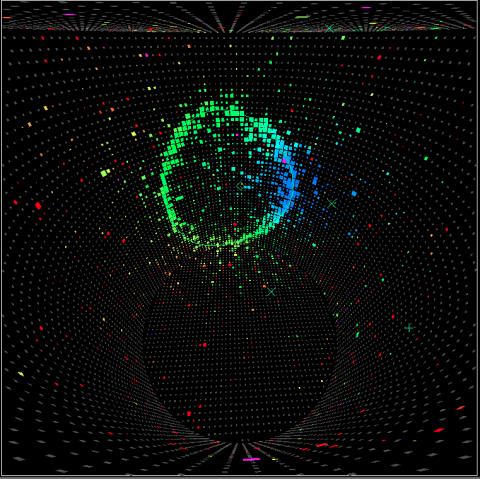New Results from T2K Conclusively Show Muon Neutrinos Transform to Electron Neutrinos
(Originally published by the Kavli IPMU)
July 19, 2013
Today at the European Physical Society meeting in Stockholm, the international T2K collaboration announced definitive observation of muon neutrino to electron neutrino transformation. In 2011, the collaboration announced the first indication of this process, a new type of neutrino oscillation, then; now with 3.5 times more data this transformation is firmly established. The probability that random statistical fluctuations alone would produce the observed excess of electron neutrinos is less than one in a trillion. Equivalently the new results exclude such possibility at a 7.5 sigma level of significance. This T2K observation is the first of its kind in that an explicit appearance of a unique flavor of neutrino at a detection point is unequivocally observed from a different flavor of neutrino at its production point.
In the T2K experiment in Japan, a muon neutrino beam is produced at the Japan Proton Accelerator Research Complex, called J-PARC, located in Tokai village, Ibaraki prefecture, on the east coast of Japan. The neutrino beam is monitored by a detector complex in Tokai and aimed at the gigantic Super-Kamiokande underground detector in Kamioka, near the west coast of Japan, 295 km (185 miles) away from Tokai. An analysis of the data from the Super-Kamiokande detector associated with the neutrino beam time from J-PARC reveals that there are more electron neutrinos (a total of 28 events) than would be expected (4.6 events) without this new process.
Neutrino oscillation is a manifestation of a long range quantum mechanical interference. Observation of this new type of neutrino oscillation leads the way to new studies of charge-parity (CP) violation, which provides a distinction in physical processes involving matter and antimatter. This phenomenon has only been observed in quarks (for which Nobel prizes were awarded in 1980 and 2008). CP violation in neutrinos in the very early universe may be the reason that the observable universe today is dominated by matter and no significant antimatter, which is one of the most profound mysteries in science. Now with T2K firmly establishing this form of neutrino oscillation that is sensitive to CP violation, a search for CP violation in neutrinos becomes a major scientific quest in the coming years, and T2K will continue to play a leading role. The T2K experiment expects to collect 10 times more data in the near future, including data with antineutrino beam for studies of CP violation in neutrinos.

The T2K experiment was constructed and is operated by an international collaboration. The current T2K collaboration consists of over 400 physicists from 59 institutions in 11 countries [Canada, France, Germany, Italy, Japan, Poland, Russia, Switzerland, Spain, UK and US]. The experiment is primarily supported by the Japanese Ministry of Education, Culture, Sports, Science and Technology (MEXT). Additional support is provided by the following funding agencies from participating countries: NSERC, NRC and CFI, Canada; CEA and CNRS/IN2P3, France; DFG, Germany; INFN, Italy; Ministry of Science and Higher Education, Poland; RAS, RFBR and the Ministry of Education and Science of the Russian Federation; MICINN and CPAN, Spain; SNSF and SER, Switzerland; STFC, U.K.; DOE, U.S.A.
The Kavli Institute for the Physics and Mathematics of the Universe (Kavli IPMU) recently joined the T2K collaboration in May of 2013, with a group consisting of individual members who have a long history of leadership on the experiment. Project Professor Mark Vagins has been a T2K collaborator since the experiment's inception, and is playing a major role in the operation of the Super-Kamiokande detector. Project Professor Chang Kee Jung has been the T2K US group spokesperson since 2004 and the International Co-spokesperson since 2011. Project Assistant Professor Mark Hartz has been a T2K collaborator since 2009 and joined the Kavli IPMU team in June of 2013. Prof. Mark Hartz has been a leader of the data analysis effort for the neutrino oscillation measurement described here. In addition to playing a central role in the coordination of analyses from all parts of the experiment, he has led the effort to simulate the production of neutrinos at the J-PARC facility and to measure the neutrino rate with the neutrino detectors located near the production point at J-PARC. Both of these efforts are essential to the observation of neutrino oscillations since it is necessary to know ahead of time how many neutrinos from oscillations or background sources should interact at Super-Kamiokande.

When asked to comment about the new T2K measurement, Prof. Hartz said, "This exciting measurement is an important step towards the goal of searching for CP violation in the oscillations of neutrinos. Now that muon neutrino to electron neutrino oscillations have been definitively detected, we have found an entirely new phenomenon through which we can look for differences in the behavior of matter and antimatter. I look forward to pursuing this research at the Kavli IPMU as a member of the T2K experiment and future neutrino oscillation experiments."
This discovery was made possible with the unyielding and tireless effort by the J-PARC staff members and the management to deliver high quality beam to T2K after the devastating March 2011 earthquake in eastern Japan, which caused severe damage to the accelerator complex at J-PARC, and abruptly discontinued the data-taking run of the T2K experiment.
More detailed information on this announcement including images, T2K experiment and T2K collaboration can be found from the T2K public webpage: http://t2k-experiment.org .
Glossary
